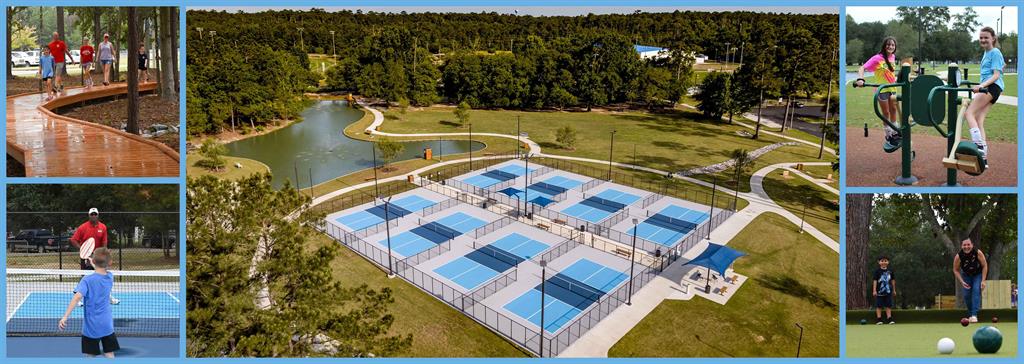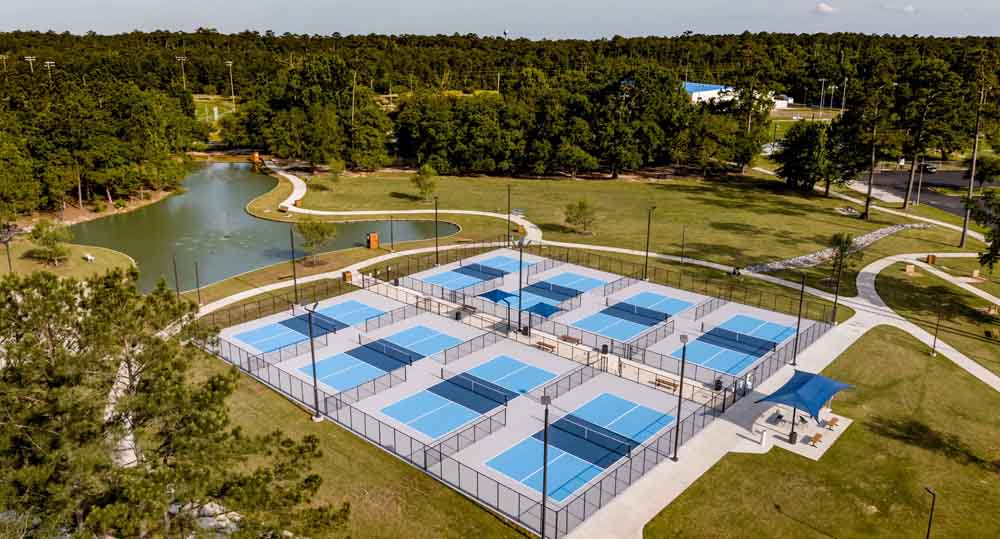

The Groves Pickleball Courts

Pelican Park offers open play pickleball at our
8 outside Pickleball Courts at The Groves! Participants are asked to bring their own
equipment (paddles and balls) to open play.
Players are requested to observe pickleball court courtesies as well as rules of good conduct on and around courts.
- No bicycles, skateboards, roller-skates, rollerblades or pets are allowed on the courts.
- No alcohol or food allowed on the courts.
- Whenever there are players waiting, players on the courts must be courteous to other patrons and share the courts after a (1/2) hour of play.
- Pickle ball court reservations are only permitted through Recreation District #1/Pelican Park. No individuals, groups, associations, clubs, or organizations are able to use The Grove pickleball courts for “private gain.” For court reservations please call: 985-626-7997
- Note: Rules, regulations and rental fees are subject to change.
Pickleball History and Name
Stories differ slightly on the origin of the name “pickleball,” but both stem from the family of one of the game creators. One version is that his wife started calling the game pickleball because the game’s combination of various existing sports reminded her of the pickle boat in crew, where oarsmen were chosen from other boats’ leftovers. The second version is that the game was named for that same family’s dog, Pickles.
Pickleball Basics
Pickleball is a paddle sport that combines elements of tennis, table tennis and badminton. It can be played by two or four players, is for all ages and abilities, and is easy to learn. It can be played on indoor or outdoor badminton-sized courts and features a modified tennis net. The sport-specific ball is plastic with holes, resembling a wiffle ball, and the paddles are larger than table tennis paddles and smaller than tennis racquets. No special attire is required, though athletic shoes and comfortable clothing are recommended.
Pickleball Fun Facts
It is estimated that 2.8 million people in the U.S. play pickleball.
- Pickleball may be played as singles or doubles and is more often played as doubles.
- Pickleball is currently most popular in school physical education programs and in senior communities, though its growth is being seen across all demographics.
- The USAPA was formed in 2005 to promote pickleball. The organization maintains the official rules, sanctions tournaments, provides player rankings and produces the annual National Pickleball Tournament.
- For even more information and complete rules, visit the USAPA’s website, www.usapa.org.
According to the USA Pickleball Association (USAPA), pickleball was invented in 1965 on Bainbridge Island, near Seattle, Wash. Three dads, whose kids were reportedly bored with their usual summer activities, are recognized with creating the game, which is now a popular sport in the United States and Canada, with growth in Europe and Asia now being seen, too.
Overview
The following is an abbreviated form of the rules to give a quick overview of how the game is played. If there is a conflict between this summary and the official rules, the official rules prevail.
Basic Rules
- Pickleball is played either as doubles (two players per team) or singles; doubles is most common
- The same size playing area and rules are used for both singles and doubles
The Serve
- The server’s arm must be moving in an upward arc when the ball is struck.
- Paddle contact with the ball must not be made above the waist level (navel level).
- The head of the paddle must not be above the highest part of the wrist at contact.
- The service motion is initiated with both feet behind the baseline and its imaginary extension. At the time the ball is struck, the server’s feet may not touch the court or outside the imaginary extension of the sideline or centerline and at least one foot must be behind the baseline on the playing surface or the ground behind the baseline.
- The serve is made diagonally crosscourt and must land within the confines of the opposite diagonal court.
- Only one serve attempt is allowed, except in the event of a let (the ball touches the net on the serve and lands on the proper service court; let serves are replayed).
Service Sequence
- Both players on the serving doubles team have the opportunity to serve and score points until they commit a fault *(except for the first service sequence of each new game).
- The first serve of each side-out is made from the right/even court.
- If a point is scored, the server switches sides and the server initiates the next serve from the left/odd court.
- As subsequent points are scored, the server continues switching back and forth until a fault is committed and the first server loses the serve.
- When the first server loses the serve the partner then serves from their correct side of the court (except for the first service sequence of the game*).
- The second server continues serving until his team commits a fault and loses the serve to the opposing team.
- Once the service goes to the opposition (at side out), the first serve is from the right/even court and both players on that team have the opportunity to serve and score points until their team commits two faults.
- In singles the server serves from the right/even court when his or her score is even and from the left/odd when the score is odd.
*At the beginning of each new game only one partner on the serving team has the opportunity to serve before faulting, after which the service passes to the receiving team.
Scoring
- Points are scored only by the serving team.
- Games are normally played to 11 points, win by 2.
- Tournament games may be to 15 or 21, win by 2.
- When the serving team’s score is even (0, 2, 4, 6, 8, 10) the player who was the first server in the game for that team will be in the right/even court when serving or receiving; when odd (1, 3, 5, 7, 9) that player will be in the left/odd court when serving or receiving.
Two-Bounce Rule
- When the ball is served, the receiving team must let it bounce before returning, and then the serving team must let it bounce before returning, thus two bounces.
- After the ball has bounced once in each team’s court, both teams may either volley the ball (hit the ball before it bounces) or play it off a bounce (ground stroke).
- The two-bounce rule eliminates the serve and volley advantage and extends rallies.
Non-Volley Zone
- The non-volley zone is the court area within 7 feet on both sides of the net.
- Volleying is prohibited within the non-volley zone. This rule prevents players from executing smashes from a position within the zone.
- It is a fault if, when volleying a ball, the player steps on the non-volley zone, including the line and/or when the player’s momentum causes them or anything they are wearing or carrying to touch the non-volley zone including the associated lines.
- It is a fault if, after volleying, a player is carried by momentum into or touches the non-volley zone, even if the volleyed ball is declared dead before this happens.
- A player may legally be in the non-volley zone any time other than when volleying a ball.
- The non-volley zone is commonly referred to as “the kitchen.”
Line Calls
- A ball contacting any part of any line, except the non-volley zone line on a serve, is considered “in.”
- A serve contacting the non-volley zone line is short and a fault.
Faults
- A fault is any action that stops play because of a rule violation.
- A fault by the receiving team results in a point for the serving team.
- A fault by the serving team results in the server’s loss of serve or side out.
Determining Serving Team
Any fair method can be used to determine which player or team has first choice of side, service, or receive. (Example: Write a 1 or 2 on the back of the score sheet.)
Click the video link below to learn more on how to play:


